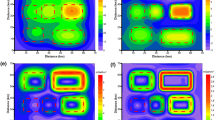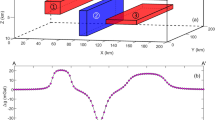Abstract
In this paper the application of an edge detection technique to gravity data is described. The technique is based on the tilt angle map (TAM) obtained from the first vertical gradient of a gravity anomaly. The zero contours of the tilt angle correspond to the boundaries of geologic discontinuities and are used to detect the linear features in gravity data. I also present that the distance between zero and \( \pm {\pi \mathord{\left/ {\vphantom {\pi 4}} \right. \kern-\nulldelimiterspace} 4} \) pairs obtained from the TAM corresponds to the depth to the top of the vertical contact model. Alternatively, the half distance between \( - {\pi \mathord{\left/ {\vphantom {\pi 4}} \right. \kern-\nulldelimiterspace} 4} \) and \( + {\pi \mathord{\left/ {\vphantom {\pi 4}} \right. \kern-\nulldelimiterspace} 4} \) radians is equal to the depth to the same model. I illustrate the applicability of the present method by gravity data due to buried vertical prisms, imaging the positions of the edges of the prisms. The results obtained from the theoretical data, with and without random noise, have been discussed. The analysis of the TAM has been demonstrated on a field example from the Kozaklı-Central Anatolian region, Turkey, and the location and depth of the edges of the structural uplifts of the Kozaklı graben are imaged. The results indicated that depth values from these sources have ranged between 0.2 and 0.6 km. I have also compared the Euler deconvolution technique with the TAM images obtained from the first vertical gradient of residual gravity anomaly. Both techniques have agreed closely in detecting the horizontal location and depth of the uplift edges in the subsurface with good precision.












Similar content being viewed by others
References
Banerjee, B., and Das Gupta, S.P. (1977), Gravitational attraction of a rectangular parallelepiped, Geophysics 42, 1053–1055.
Bozkurt, E. (2001), Neotectonics of Turkey—a synthesis, Geodinamica Acta 14, 3–30.
Cooper, G.R.J. (2003), Feature detection using sunshading, Comput. Geosci. 29, 941–948.
Cordell, L., and Grauch, V.J.S. (1985), Mapping basement magnetization zones from aeromagnetic data in the San Juan basin, New Mexico, In Hinzc W.J. (Ed.). The utility of regional gravity and magnetic anomaly maps, Soc. Expl. Geophys., pp. 181–197.
Ekingen, A. (1971), Gravimetric method in geothermal field explorations and its application in Turkey, First geothermal energy symposium of Turkey, Ankara, pp. 60–74.
Evjen, H.M. (1936), The place of the vertical gradient in gravitational interpretations, Geophysics 1, 127–136.
Gunn, P.J. (1975), Linear transformations of gravity and magnetic fields, Geophys. Prospect. 23, 300–312.
Hansen, R.O., Pawlowski, R.S., and Wang, X. (1987), Joint use of analytic signal and amplitude of horizontal gradient maxima for three-dimensional gravity data interpretation, 57th annual international management, Soc. Expl. Geophys., Expanded Abstracts 100–102.
Hsu, S.-K. (2002), Imaging magnetic sources using Euler’s equation, Geophys. Prospect. 50, 15–25.
Klingele, E.E., Marson, I., and Kahle, H.G. (1991), Automatic interpretation of gravity gradiometrıc data in two dimensions: vertical gradient, Geophys. Prospect. 39, 407–434.
Maden Tetkik ve Arama Enstitüsü (mta). (1997), Geological map 1/100,000 scale, Yozgat sheet G 19 and explanatory note. Ins. Min. Res. Explor., pp. 8.
Miller, H.G., and Singh, V. (1994), Potential field tilt—a new concept for location of potential field sources, J. Appl. Geophys. 32, 213–217.
Oruç, B., and Keskinsezer, A. (2008), Structural setting of the northeastern Biga Peninsula (Turkey) from tilt derivatives of gravity gradient tensors and magnitude of horizontal gravity components, Pure Appl. Geophys. 165, 1913–1927.
Pawlowski, R.S. (1997), Use of the slant stack for geologic or geophysical map lineament analysis, Geophysics 62, 1774–1778.
Rajagopalan, S., and Milligan, P. (1995), Image enhancement of aeromagnetic data using automatic gain control, Explor. Geophys. 25, 173–178.
Reid, A.B., Allsop, J.M., Granser, H., Milett, A.J., Somerton, I. (1990), Magnetic interpretation in tree dimensions using Euler deconvolution, Geophysics 55, 80–91.
Salem A., Williams S., Fairhead J.D., Ravat D.J., and Smith R. (2007), Tilt-depth method: a simple depth estimation method using first-order magnetic derivatives, Lead. Edge, 1502–1505.
Serpen, U., Aksoy, N., Öngür, T., and Korkmaz, E.D. (2009), Geothermal energy in Turkey: 2008 update, Geothermics 38, 227–237.
Thompson, D.T. (1982), EULDPH: a technique for making computer assisted depth estimates from magnetic data, Geophysics 47, 31–37.
Thurston, J.B., and Smith, R.S. (1997), Automatic conversion of magnetic data to depth, dip, and susceptibility contrast using the SPI TM method, Geophysics 62, 807–813.
Verduzco, B., Fairhead, J.D., Green, C.M., and Mackenzie, C. (2004), New ınsights into magnetic derivatives for structural mapping, Lead. Edge 23, 116–119.
Wijns, C.C.P., and Kowalczyk, P. (2005), Theta map: edge detection in magnetic data, Geophysics 70, L39–L43.
Acknowledgments
Thanks to the General Directorate of Mineral Research and Exploration of Turkey for permitting me to use their gravity data and geological map. I also thank the referees for making valuable suggestions and comments in improving the text.
Author information
Authors and Affiliations
Corresponding author
Appendix A: Derivation of structural index from the second vertical gravity gradient of semi-infinite contact
Appendix A: Derivation of structural index from the second vertical gravity gradient of semi-infinite contact
For 2D sources, where \( {{\partial^{2} g_{z} } \mathord{\left/ {\vphantom {{\partial^{2} g_{z} } {\partial y\partial z}}} \right. \kern-\nulldelimiterspace} {\partial y\partial z}} = 0 \), Eq. (12) is written as
The derivatives of Eq. (3) with respect to x and z are defined, respectively;
and
Substitution into the left-hand side of Euler’s Eq. (A1) yields
If Eq. (A4) is compared with the right-hand side of Eq. (A1), the structural index N leads to 1.0.
Rights and permissions
About this article
Cite this article
Oruç, B. Edge Detection and Depth Estimation Using a Tilt Angle Map from Gravity Gradient Data of the Kozaklı-Central Anatolia Region, Turkey. Pure Appl. Geophys. 168, 1769–1780 (2011). https://doi.org/10.1007/s00024-010-0211-0
Received:
Revised:
Accepted:
Published:
Issue Date:
DOI: https://doi.org/10.1007/s00024-010-0211-0




